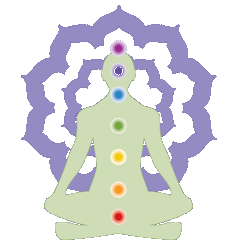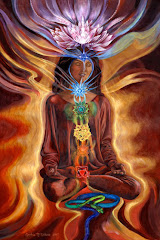We are all already enlightened. It's just that the ego has a problem with being displaced, so it works hard to keep us engaged, and thus distracted from the present moment and our enligtened state.
Our minds are like pure, colorless gems or crystals. If you put the crystal up against a red cloth, it appears red, and against a blue cloth, blue, etc. But it never loses its inherent clairty, and can be returned to its natural state by allowing the background to drop away. So our minds, with their constantly shifting colors and emotions, keep us caught up in all sorts of things. Our emotions and judgments are the filters we see the world through. If you are angry, you will respond differently to a situation than if you are calm. Now, the point is not to never be angry or experience negative emotions. We are human. But, when we become angry or sad or unhappy, if we can recognize that this is just a color passing through, then we can drop a lot of what is bothering us and feel more peaceful in the moment. Even if our negative emotions feel overpowering, this is just a trick of the ego. These emotions are not our true Selves, and learning how to stay balanced and equinamous during the shifting of emotions and moods is a huge step toward dropping the ego.
This dropping of the ego is incredibly hard to describe because it is not something that can be put into words. Rather, when the ego drops away, so does language and many other forms of mind-chatter that feel normal because we are so used to them. Learning to detach from the ego is a process. It can be compared to learning Ujjayi breath or Bandha control. At first, it may not make sense and you cannot do it. Then, slowly, an understanding happens. Over time, our new abilities become our "natural state" and it's hard to remember a time when we did not know how to do these things. So, when the ego drops away at first, it may be for just one split second. Then, often, the mind kicks in, saying "HEY! Did you see that! The ego's gone!" Another trick, since this is the ego talking! Go back to the breath. Don't try to drop thoughts, just let them float past & dissolve on their own. Keep doing this, and you will gain clarity, as well as much insight into the human mind, ego, and higher Self. You will be directing your ego, instead of it directing you. And you will be able to find bliss and beauty in each moment.
Tuesday, April 29, 2008
Sunday, April 27, 2008
We are what we think we are
Because we use this wonderful thing called language, we put labels on everything, ourselves included. We already know from yoga and meditation that we are more than the language-chatter in the mind, and that labels can limit our experience of life. It is very easy to dismiss something after it has been named with a word.
As far as we ourselves are concerned, labels are often self-fulfilling prophecies and are so outdated that they no longer apply, yet we continue to play them out. I'm reminded of the old study in which they took 2 random groups of 5th graders & told one group that they were very talented at math. The other group was told they were average or below average. When the groups were tested, the one that had a better self-image, who though of themselves as talented, tested better. Once again, this demonstrates the power of our thoughts, and this is why we try to harness the thoughts and make THEM work for US, rather than the other way around.
If you think of yourself as someone who is a worrier, messy, lazy, negative, unlucky, etc., then your are keeping these labels adhered to yourself, and they will drain your mental and emotional energy. BUT if you think of yourself as someone who is happy, positive, fortunate, resilient, compassionate, kind, etc... then these labels will begin to stick in your mind, and even if you are not feeling all that positive, starting to view yourself as a positive person can literally transform your self-image from the inside out. The path of tantra involves viewing ourselves as a deity who can act in this world with ultimate clarity & compassion. Even though 99% of us aren't currently able to do that, at least not on a consistent basis, acting as though it is already true moves us continually in that direction. We learn to see ourselves and all others as divine, and our mind is used as a compassionate ally rather than a slave to the hungry ego.
So remember: you are what you think you are. And you are already divine.
As far as we ourselves are concerned, labels are often self-fulfilling prophecies and are so outdated that they no longer apply, yet we continue to play them out. I'm reminded of the old study in which they took 2 random groups of 5th graders & told one group that they were very talented at math. The other group was told they were average or below average. When the groups were tested, the one that had a better self-image, who though of themselves as talented, tested better. Once again, this demonstrates the power of our thoughts, and this is why we try to harness the thoughts and make THEM work for US, rather than the other way around.
If you think of yourself as someone who is a worrier, messy, lazy, negative, unlucky, etc., then your are keeping these labels adhered to yourself, and they will drain your mental and emotional energy. BUT if you think of yourself as someone who is happy, positive, fortunate, resilient, compassionate, kind, etc... then these labels will begin to stick in your mind, and even if you are not feeling all that positive, starting to view yourself as a positive person can literally transform your self-image from the inside out. The path of tantra involves viewing ourselves as a deity who can act in this world with ultimate clarity & compassion. Even though 99% of us aren't currently able to do that, at least not on a consistent basis, acting as though it is already true moves us continually in that direction. We learn to see ourselves and all others as divine, and our mind is used as a compassionate ally rather than a slave to the hungry ego.
So remember: you are what you think you are. And you are already divine.
Friday, April 25, 2008
Sun A Challenge!
Try this for the following week (hey, why not start on Saturday and end on Saturday?):
As soon as you get out of bed in the morning, begin your Ujjayi breath and do three Sun A's. That's it.
Notice how different the 2nd Sun A feels from the 1st. Feel your body waking up by the 3rd.
Depending on your rate of breath, one Sun A takes under a minute, maybe even 30 seconds or less. So try to commit to doing this 3-minute-or-less-practice every morning for 1 week. This will give you a nice glimpse of a regular home practice and its benefits.
Namaste!
As soon as you get out of bed in the morning, begin your Ujjayi breath and do three Sun A's. That's it.
Notice how different the 2nd Sun A feels from the 1st. Feel your body waking up by the 3rd.
Depending on your rate of breath, one Sun A takes under a minute, maybe even 30 seconds or less. So try to commit to doing this 3-minute-or-less-practice every morning for 1 week. This will give you a nice glimpse of a regular home practice and its benefits.
Namaste!
Wednesday, April 23, 2008
Regarding the Handbook...
A good reminder to all: Be kind to yourself when you practice yoga. Go slowly, especially in the beginning, and listen to your body. It knows what it can do. If it says "stop," stop. Don't push it. Yoga is not a competitive sport. You don't win points for matching a picture in a book (or in a handout!).If you've been looking at some of the poses in the Second Series and beyond, I hope you can feel inspired rather than discouraged. Please don't feel you have to be able to do any of those poses, especially if you are new to the practice. I overheard several people sitting on the couches saying, as they flipped through the booklet, "I could NEVER do that!" - I understand the sentiment, but guess what: that's the ego talking. It may not seem so, since it's a negative statement, but the ego loves to focus on what we CAN'T do, rather than what we CAN. So if you get trapped in a negative thought pattern regarding yoga, immediately remind yourself that with even one Ujjayi breath, you are practicing powerful yoga. When it comes right down to it, everything else is just details :)
Ashtanga Practice Booklet
Hello all! I have just finished putting together an Ashtanga Yoga Practice Booklet, which will be available for FREE at A2 Yoga starting today. No fancy binding or anything, but it contains the opening and closing mantras, images of ALL the poses (first AND second series, plus more!), and lots of useful info and reminders about energy flow, Ujjayi breath, and Bandha control.
I'm hoping it will provide both useful information and references, as well as inspiration.
I'll be giving it out in class, or you can pick up a copy from the front counter. Even those who practice styles other than Ashtanga may find it interesting.
I'm hoping it will provide both useful information and references, as well as inspiration.
I'll be giving it out in class, or you can pick up a copy from the front counter. Even those who practice styles other than Ashtanga may find it interesting.
Wednesday, April 9, 2008
The yoga of happiness
We know our minds are very powerful; they run the daily chatter that we consider the 'self'; they can evoke fear responses when nothing is there to be afraid of, they can realign the body's stance & skeletal structure by focusing on metaphors of the spine lengthening like a string, etc.
Often, our minds have a tendency to focus on the negative: what we didn't accomplish rather than what we did; the few details that didn't go perfectly during a presentation as opposed to the overall fact that it went well. And we know that focusing on these things removes us from the present moment. Our minds can easily become jails, replaying unpleasant moments and memories long after they are gone.
But our minds can also be trained to have a continual positive focus. Not to the point of being unrealistically positive about everything, but rather tapping into that yogic non-attachment and acceptance of all things that happen. Yes, ALL things. Especially the irritating ones. The extra long bank line when you are already late. The person who is rude to you. Your own irritability and frustration itself. Because then eventually, you realize that you and life are not separate. There is no 'you' to exist separately. And this is a wonderful thing.
Often, our minds have a tendency to focus on the negative: what we didn't accomplish rather than what we did; the few details that didn't go perfectly during a presentation as opposed to the overall fact that it went well. And we know that focusing on these things removes us from the present moment. Our minds can easily become jails, replaying unpleasant moments and memories long after they are gone.
But our minds can also be trained to have a continual positive focus. Not to the point of being unrealistically positive about everything, but rather tapping into that yogic non-attachment and acceptance of all things that happen. Yes, ALL things. Especially the irritating ones. The extra long bank line when you are already late. The person who is rude to you. Your own irritability and frustration itself. Because then eventually, you realize that you and life are not separate. There is no 'you' to exist separately. And this is a wonderful thing.
Monday, April 7, 2008
Yoga: Moving Meditation
We all come to yoga looking for something. It may be relief from a sore back or tight hamstrings, but often it's more.
From "Minding What Matters" by Robert Langdon:
"A contemporary monk remarks that under meditative concentration 'the convention of personality starts to unfold into energetic patterns - patterns that are ephemeral but karmically potent when they're held onto... You experience yourself more like an energetic sphere of sensitivity than as a six-foot tall vertebrate who's a man or a woman... the mind itself becomes different... part of what is going on... [not] some separate thing that thinks and decides [and judges]."
From "Minding What Matters" by Robert Langdon:
"A contemporary monk remarks that under meditative concentration 'the convention of personality starts to unfold into energetic patterns - patterns that are ephemeral but karmically potent when they're held onto... You experience yourself more like an energetic sphere of sensitivity than as a six-foot tall vertebrate who's a man or a woman... the mind itself becomes different... part of what is going on... [not] some separate thing that thinks and decides [and judges]."
Subscribe to:
Posts (Atom)




